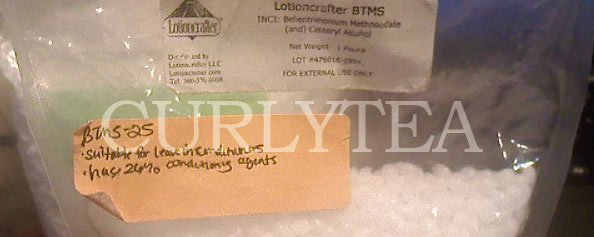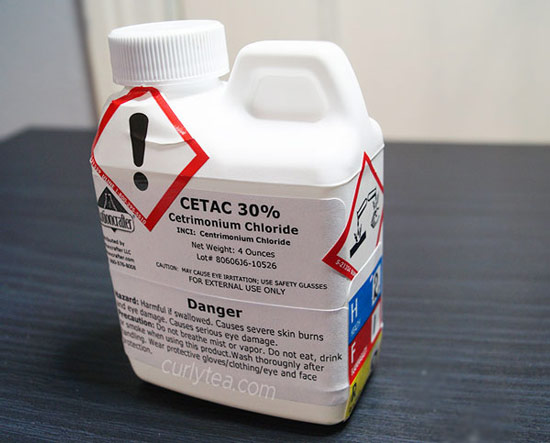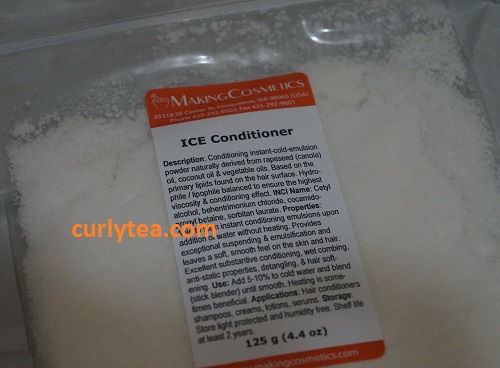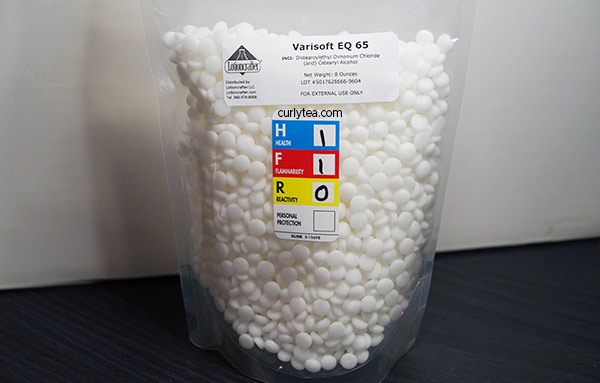INCI: Behentrimonium Methosulfate (and) Cetearyl Alcohol
BTMS-25 was my fav emulsifier until I used BTMS-50. Granted, I haven't had an opportunity to use every and all emulsifiers, but BTMS-25 is one that I have the least amount of problems with and it doesn't really conflict with a whole lot of other ingredients.
BTMS-25 is what is called a conditioning self emulsifier, meaning that it's supposedly powerful enough to use by itself as the only emulsifier. Its very good at keeping the oil and water from separating even if it's the only emulsifier in my experience. And it helps to condition the hair too.
The only problem I've had using BTMS-25 is when I didn't use quite enough of it (this was, of course, before I got my ingredient/kitchen scale and was relying on teaspoon/tablespoon measurements).
Being cationic, it is said to have a positive charge… which helps to attract it to the negatively charged hair. The more attracted an ingredient is, the better it conditions. By the way, some conditioners are said to have lower ph for this very reason.
It can also be used in anhydrous oil only formulas, like whipped butters, to add extra conditioning properties to it.
Recommended Usage Rate: 1 – 10%





Good Morning, many blessings. So i just had a question, if you could provide any additional knowledge/advice. So I am making a beard wash. I am working with BTMS 25. I fear to use too much even knowing that it is suppose to be an organic product, but i am still experiencing separation. I’ve watched a few of your videos and i have gathered that i’m probably just not using enough emulsifier. Do you believe that is the reason? I know you don’t know the exact amount of liquid, but, kind of a shot in the dark if you will. Lol. Thank you for your time and i hope i can get a response. Good Day.
Hi! Based on everything I’ve learned about cleansers and shampoos, the formulas are greatly diminished with the addition of a conditioning emulsifier. BTMS is cationic (positive) in charge. Many of the best surfactants are anionic (negative) in charge. The two don’t mix and will cause all kinds of problems. Also, if you’re using Xanthan gum to thicken the water portion, it doesn’t work well with BTMS.
I’m assuming you need an emulsifier because you’re also incorporating oil-soluble ingredients into this wash. If you add traditional emulsifying conditioners and oils to surfactants (cleansing agents), it essentially becomes a glorified conditioner instead of a cleansing product. If you want to add a conditioning feel to a cleansing formula, try to use something like Polyquaternium 7 or Polyquaternium 10 along with a refatting agent like Glyceryl Oleate. I know. Polyquats are not natural ingredients but, much to my disappointment, they tend to work very well in cleansing formulas. They’re cationic ingredients which work well with anionic surfactants too.
Many cosmetic chemists recommend no more than 1% oil (total) in cleansing products, which means you could get away with using a solubilizer instead of a full blown emulsifier. They also say many of the big companies use extremely small percentages of oils simply to be able to market the product well. Keep than in mind when you’re formulating.
In addition, when I see BTMS in a cleansing product, I’m not sure if it’s used as the primary emulsifier. It may be used to add a little conditioning while the other heavy duty emulsifiers are doing the real work of keeping the formula from separating. Most likely if you see BTMS in a cleanser, they’re using nonionic and amphoteric surfactants and not anionic surfactants. (Anionic surfactants are the best at cleaning).
Sorry I couldn’t be of more help. Cleansing products are some of the most notorious products to make if you want them to be effective.